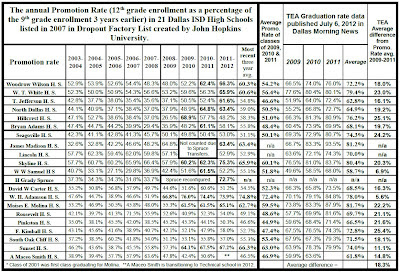The DISD rate allows for the "coding in or out" of students who transfer between schools, who leave DISD, who die, or who have other valid reasons for transfering out of DISD. Except for the 8th to 9th grade transfer, enrollment numbers always go down from grade to grade in DISD. Most of the transfers are transfers out, and allow DISD to remove that child from any "dropout" designation.
There are two critical questions. First, how many of these transfers are valid versus how many are used as a cover so as to get a higher graduation rate? Second, since the non-dropouts should be transfering to another school, where is the school with increasing enrollment? When you expand the counting to the entire state of Texas ( http://www.studentmotivation.org/DallasISD.htm ) you find that the students being lost, and showing up in no other school in Texas, are not accounted for in the official TEA graduation rate. They may claim that these students are leaving Texas, but why is Texas not loosing population? A 9th grade cohort graduation rate far below what is claimed by TEA is indicated.
The following chart shows the contrast between what is certainly one of the most widely known national graduation rate tabulations, the Promotion Rate, and the rate that is used by Dallas ISD, similar to the TEA method.
 |
| Comparison of Dallas ISD Graduation Rate Claims by High School (Right-click and click "open link" to enlarge and/or print.) |
Since the DISD claims a 2011 graduation rate of 77% and my "raw graduation rate" (http://schoolarchiveproject.blogspot.com/2012/05/dallas-isd-academic-graduation-rate.html) of 52% for 2011 are 25 percentage points apart, these calculations are almost perfect.
Do we help our students by somehow lessening the degree of urgency regarding students not graduating in Dallas? Who does this help?
